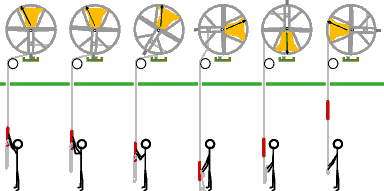
|
St. Peter-ad-Vincula, Coggeshall.Bellringers President: Revd. Chris Davey |
| | Home | Gallery | Notice Board | Contact Us | |
Church bell ringing is often something that is either the butt of jokes about people jumping up and down on the end of ropes or something that people often say they have always wanted to have a go at. In both cases, the people concerned know very little about what is involved in learning to ring. Teaching is done on a one to one basis at a pace that is right for the student. It is possible to be able to handle a bell in a few sessions of teaching but some people take much longer. It is not a race. If the student is willing to learn, has a sense of rhythm and can count, they have all that is required to succeed. The only other requirement is that, once taught, they are prepared to ring for Sunday services.
We teach our students by using a simulator This means that the clapper of the bell is tied so that no sound is made and the sound is transmitted by the aid of sensors to a computer. We have eight bells that can be used this way which means that at a later stage, ringers can learn new methods on the simulator, without any sound being heard outside.
There are two different strokes in ringing a bell. Each stroke turns the bell 360 degrees. We start with the back stroke when there is the smallest amount of rope hanging from the ceiling, the rest being wound round a wheel at the side of the bell.

The student reaches up and holds the rope and then with guidance pulls the rope straight down continuing the pull through down to thigh level It is like a golf swing which has to be followed through once the ball has been hit. This stroke brings the fluffy bit of the rope, called a sally, down and later the student will learn to catch the sally At the beginners stage, the tutor does the catching. The second stroke is when the end of the rope and the sally are pulled together, then keeping hold of the tail end, the sally is released which lets the rope go back to being wound round the wheel ready to start the back stroke again The back stroke is learnt first, then the handstroke and then they are put together to complete the process
At all stages there is support and guidance from the tutor. Our tutors use the Integrated Teaching Training Scheme to ensure that standards are uniform throughout and that each student progresses at their own pace.
Once the beginner is confident with ringing the bell, he/she is introduced to ringing with other people, learning to ring the bell so that it is evenly spaced between two other bells. Ringing is a team activity and everyone works with everyone else to make sure that the sound that is heard by people outside the church is as good as possible.